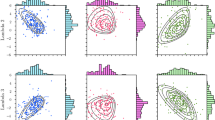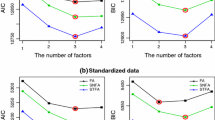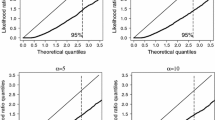Abstract
Factor analysis is a classical data-reduction technique that seeks a potentially lower number of unobserved variables that can account for the correlations among the observed variables. This paper presents an extension of the factor analysis model, called the skew-\(t\) factor analysis model, constructed by assuming a restricted version of the multivariate skew-\(t\) distribution for the latent factors and a symmetric \(t\)-distribution for the unobservable errors jointly. The proposed model shows robustness to violations of normality assumptions of the underlying latent factors and provides flexibility in capturing extra skewness as well as heavier tails of the observed data. A computationally feasible expectation conditional maximization algorithm is developed for computing maximum likelihood estimates of model parameters. The usefulness of the proposed methodology is illustrated using both simulated and real data.



Similar content being viewed by others
References
Aas K, Haff IH (2006) The generalised hyperbolic skew student’s \(t\)-distribution. J Financ Econ 4:275–309
Aitken AC (1926) On Bernoulli’s numerical solution of algebraic equations. Proc R Soc Edinburgh 46:289–305
Akaike H (1973) Information theory and an extension of the maximum likelihood principle. In: Petrov BN, Csaki F (Eds.) 2nd international symposium on information theory. Akademiai Kiado, Budapest, pp 267–281
Anderson TW (2003) An introduction to multivariate statistical analysis, 3rd edn. Wiley, New York
Azzalini A (1985) A class of distributions which includes the normal ones. Scand J Stat 12:171–178
Azzalini A (2005) The skew-normal distribution and related multivariate families. Scand J Stat 32:159–188
Azzalini A, Capitanio A (1999) Statistical applications of the multivariate skew normal distribution. J R Stat Soc Ser B 61:579–602
Azzalini A, Capitanio A (2003) Distributions generated by perturbation of symmetry with emphasis on a multivariate skew \(t\)-distribution. J R Stat Soc Ser B 65:367–389
Azzalini A, Dalla Valle A (1996) The multivariate skew-normal distribution. Biometrika 83:715–726
Azzalini A, Genton MG (2008) Robust likelihood methods based on the skew-\(t\) and related distributions. Int Stat Rev 76:106–129
Barndorff-Nielsen O, Shephard N (2001) Non-Gaussian Ornstein–Uhlenbeck-based models and some of their uses in financial economics. J R Stat Soc Ser B 63:167–241
Basilevsky A (2008) Statistical factor analysis and related methods: theory and applications. Wiley, New York
Böhning D, Dietz E, Schaub R, Schlattmann P, Lindsay B (1994) The distribution of the likelihood ratio for mixtures of densities from the one-parameter exponential family. Ann Inst Stat Math 46:373–388
Bozdogan H (1987) Model selection and Akaike’s information criterion (AIC): the general theory and its analytical extensions. Psychometrika 52:345–370
Branco MD, Dey DK (2001) A general class of multivariate skew-elliptical distributions. J Multivar Anal 79:99–113
Cook RD, Weisberg S (1994) An introduction to regression graphics. Wiley, New York
Dempster AP, Laird NM, Rubin DB (1977) Maximum likelihood from incomplete data via the EM algorithm (with discussion). J R Stat Soc Ser B 39:1–38
Efron B, Hinkley DV (1978) Assessing the accuracy of the maximum likelihood estimator: observed versus expected fisher information (with discussion). Biometrika 65:457–487
Efron B, Tibshirani R (1986) Bootstrap method for standard errors, confidence intervals, and other measures of statistical accuracy. Stat Sci 1:54–77
Fokoué E, Titterington DM (2003) Mixtures of factor analyzers. Bayesian estimation and inference by stochastic simulation. Mach Learn 50:73–94
Hannan EJ, Quinn BG (1979) The determination of the order of an autoregression. J R Stat Soc Ser B 41:190–195
Healy MJR (1968) Multivariate normal plotting. Appl Stat 17:157–161
Ho HJ, Lin TI, Chang HH, Haase HB, Huang S, Pyne S (2012) Parametric modeling of cellular state transitions as measured with flow cytometry different tissues. BMC Bioinform 13(Suppl 5):S5
Jamshidian M (1997) An EM algorithm for ML factor analysis with missing data. In: Berkane M (ed) Latent variable modeling and applications to causality. Springer, New York, pp 247–258
Johnson RA, Wichern DW (2007) Applied multivariate statistical analysis, 6th edn. Pearson Prentice-Hall, Upper Saddle River
Jones MC, Faddy MJ (2003) A skew extension of the \(t\)-distribution with applications. J R Stat Soc Ser B 65:159–174
Kotz S, Nadarajah S (2004) Multivariate \(t\) distributions and their applications. Cambridge University Press, Cambridge
Lachos VH, Ghosh P, Arellano-Valle RB (2010) Likelihood based inference for skew normal independent linear mixed models. Stat Sin 20:303–322
Lange KL, Little RJA, Taylor JMG (1989) Robust statistical modeling using the \(t\) distribution. J Am Stat Assoc 84:881–896
Lawley DN, Maxwell AE (1971) Factor analysis as a statistical method, 2nd edn. Butterworth, London
Lee S, McLachlan GJ (2013) On mixtures of skew normal and skew \(t\)-distributions. Adv Data Anal Classif 7:241–266
Lee S, McLachlan GJ (2014) Finite mixtures of multivariate skew \(t\)-distributions: some recent and new results. Stat Comp 24:181–202
Lee YW, Poon SH (2011) Systemic and systematic factors for loan portfolio loss distribution. Econometrics and applied economics workshops, School of Social Science, University of Manchester, pp 1–61
Lin TI, Ho HJ, Chen CL (2009) Analysis of multivariate skew normal models with incomplete data. J Multivari Anal 100:2337–2351
Lin TI, Lee JC, Ho HJ (2006) On fast supervised learning for normal mixture models with missing information. Pattern Recog 39:1177–1187
Lin TI, Lee JC, Hsieh WJ (2007a) Robust mixture modeling using the skew \(t\) distribution. Stat Compt 17:81–92
Lin TI, Lee JC, Yen SY (2007b) Finite mixture modelling using the skew normal distribution. Stat Sin 17:909–927
Lin TI, Lin TC (2011) Robust statistical modelling using the multivariate skew \(t\) distribution with complete and incomplete data. Stat Model 11:253–277
Lin TI, McLachlan GJ, Lee SX (2013) Extending mixtures of factor models using the restricted multivariate skew-normal distribution. Preprint arXiv:1307.1748
Lindsay B (1995) Mixture models: theory. Geometry and applications. Institute of Mathematical Statistics, Hayward
Liu M, Lin TI (2014) Skew-normal factor analysis models with incomplete data. J Appl Statist. doi:10.1080/02664763.2014.986437
Lopes HF, West M (2004) Bayesian model assessment in factor analysis. Stat Sin 14:41–67
Louis TA (1982) Finding the observed information when using the EM algorithm. J R Stat Soc Ser B 44:226–232
McLachlan GJ, Peel D (2000) Finite Mixture Models. Wiley, New York
McLachlan GJ, Bean RW, Jones LBT (2007) Extension of the mixture of factor analyzers model to incorporate the multivariate \(t\)-distribution. Comput Stat Data Anal 51:5327–5338
McNicholas PD, Murphy TB, McDaid AF, Frost D (2010) Serial and parallel implementations of model-based clustering via parsimonious Gaussian mixture models. Comput Stat Data Anal 54:711–723
Meng XL, Rubin DB (1993) Maximum likelihood estimation via the ECM algorithm: a general framework. Biometrika 80:267–278
Montanari A, Viroli C (2010) Heteroscedastic factor mixture analysis. Stat Model 10:441–460
Murray PM, Browne RP, McNicholas PD (2013) Mixtures of ‘unrestricted’ skew-\(t\) factor analyzers. Preprint arXiv:1310.6224v1
Murray PM, Browne RP, McNicholas PD (2014a) Mixtures of skew-\(t\) factor analyzers. Comput Stat Data Anal 77:326–335
Murray PM, McNicholas PD, Browne RP (2014b) Mixtures of common skew-\(t\) factor analyzers. Stat 3:68–82
Pyne S, Hu X, Wang K, Rossin E, Lin TI, Maier LM, Baecher-Allan C, McLachlan GJ, Tamayo P, Hafler DA, De Jager PL, Mesirov JP (2009) Automated high-dimensional flow cytometric data analysis. Proc Natl Acad Sci USA 106:8519–8524
Rossin E, Lin TI, Ho HJ, Mentzer SJ, Pyne S (2011) A framework for analytical characterization of monoclonal antibodies based on reactivity profiles in different tissues. Bioinformatics 27:2746–2753
Sahu SK, Dey DK, Branco MD (2003) A new class of multivariate skew distributions with application to Bayesian regression models. Can J Stat 31:129–150
Schwarz G (1978) Estimating the dimension of a model. Ann Stat 6:461–464
Sclove LS (1987) Application of model-selection criteria to some problems in multivariate analysis. Psychometrika 52:333–343
Spearman C (1904) General intelligence, objectively determined and measured. Am J Psychol 15:201–292
Tortora C, McNicholas PD, Browne R (2013) A mixture of generalized hyperbolic factor analyzers. Preprint arXiv: 1311.6530v1
Wall MM, Guo J, Amemiya Y (2012) Mixture factor analysis for approximating a non-normally distributed continuous latent factor with continuous and dichotomous observed variables. Multivar Behav Res 47:276–313
Wang K, McLachlan GJ, Ng SK, Peel D (2009) EMMIX-skew: EM algorithm for mixture of multivariate skew normal/\(t\) distributions. R package version 1.0-12
Wang WL, Lin TI (2013) An efficient ECM algorithm for maximum likelihood estimation in mixtures of \(t\)-factor analyzers. Comput Stat 28:751–769
Zacks S (1971) The theory of statistical inference. Wiley, New York
Zhang J, Li J, Liu C (2013) Robust factor analysis using the multivariate \(t\)-distribution. unpublished manuscript
Acknowledgments
We are grateful to the Editor-in-Chief, the Associate Editor and two anonymous referees for their insightful comments and suggestions, which led to a much improved version of this article. This research was supported by MOST 103-2118-M-005-001-MY2 awarded by the Ministry of Science and Technology of Taiwan.
Author information
Authors and Affiliations
Corresponding author
Electronic supplementary material
Below is the link to the electronic supplementary material.
Rights and permissions
About this article
Cite this article
Lin, TI., Wu, P.H., McLachlan, G.J. et al. A robust factor analysis model using the restricted skew-\(t\) distribution. TEST 24, 510–531 (2015). https://doi.org/10.1007/s11749-014-0422-2
Received:
Accepted:
Published:
Issue Date:
DOI: https://doi.org/10.1007/s11749-014-0422-2




